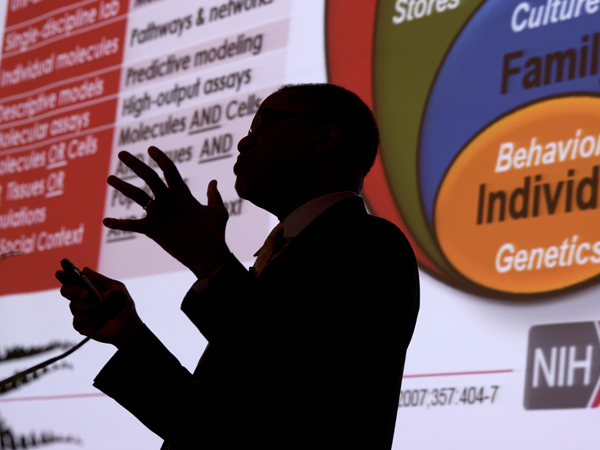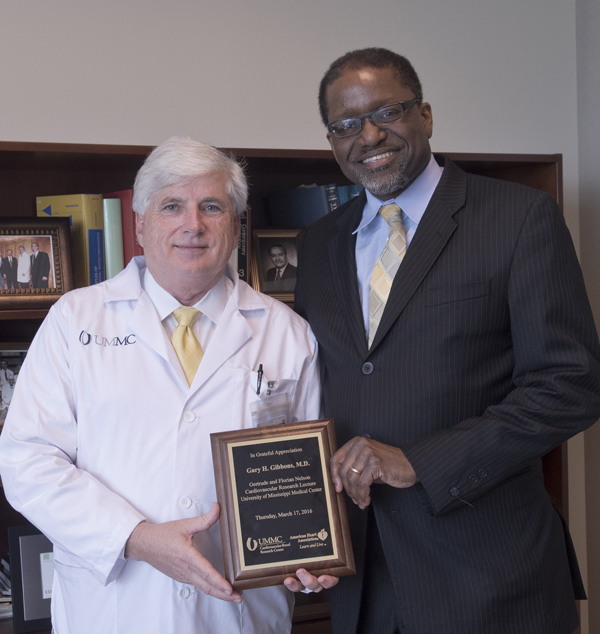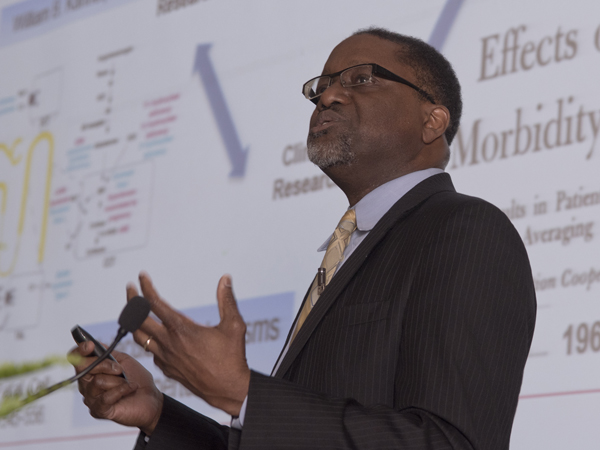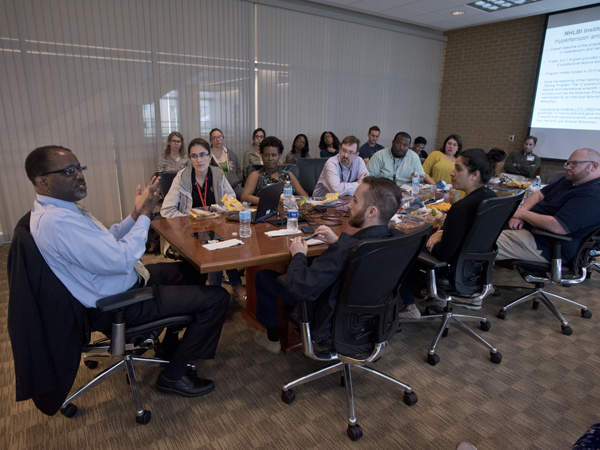Gibbons: funding the future makes disease history

Dr. Gary Gibbons asked UMMC a lot of "what if" questions.
What if heart disease could go into remission? What if biomedical science was considered information science? What if we could precisely predict and preempt disease?
Gibbons, director of the National Heart, Lung and Blood Institute (NHLBI), shared his vision for the future of cardiovascular health when he visited campus Mar. 17-18. He delivered the 19th Gertrude and Florian Nelson Cardiovascular Research Lecture, "Building on the NHLBI Legacy of Hypertension Research: Charting Our Future Together," on Thursday.
The Cardiovascular Renal Research Center (CRRC) sponsors the annual event that brings renowned scientists to UMMC.

"UMMC has a long history of funding from NHLBI," said Dr. Joey Granger, director of CRRC and professor of physiology. The Medical Center received $15 million from NHLBI last year.
Like saving for retirement, "It's important to have a diversified portfolio," Gibbons said of funding projects. Basic, translational, clinical and population research programs are all valuable to the advancement of public health.
The Medical Center's relationship with the NHLBI reaches back to the 1960s, when the institute funded the late Dr. Arthur Guyton's cardiovascular research. Today, NHLBI funds long-term projects including the Atherosclerosis Risk in Communities (ARIC) study and the Jackson Heart Study, as well as various research and training grants.
Gibbons anticipates great changes in preventive medicine. He illustrated his vision with "Carla," a fictional 40-year-old in 2020. A combination of genetics and stress increase Carla's risk for hypertension and kidney disease. Through her physician's care, wearable health monitor and "smart bottle" technology that reminds Carla to take medications, she avoids the diseases.
"I think that in five to ten years this kind of approach will be routine," Gibbons said.

Two concepts make this possible, Gibbons says. One is to understand human genetics and health within an ecosystem. A person's environment — family, community or city — influences exercise and diet, disease exposure and social stresses. These factors make up the "exposome," the total surrounding environment, which influences health.
Gibbons used an example from his own ancestry. Sickle-cell trait, common in African-Americans, confers malaria protection. This is advantageous in sub-Saharan Africa where the disease is common. However, the trait is linked with higher risk for chronic kidney disease.
The other approach is "biomedicine as information science," Gibbons said. With big data, analytics and "-omics" like genomics and proteomics, precision medicine is possible. Gibbons compared the approach to Amazon's personalized purchase suggestions based on user history.
"This is what clinicians should do: gather data as soon as a patient walks through the door. Look at them and ask, 'What is their affect?' 'Do they look sick?' 'Should I call a code?'" Gibbons said. "By not doing this, how much data are we missing?"
Gibbons also addressed the need to expand diversity in biomedical science. For example, African-Americans comprise 12.6% of the general population but only 1.1% of principal investigators on National Institutes of Health (NIH) grants.
The Medical Center's location in Jackson, Gibbons said, "provides a great opportunity to reach earlier into the pipeline," and recruit young talent from underrepresented minorities. This is possible through program collaborations, such as those with Jackson State University and Tougaloo College.
"You are promoting the next generation of researchers locally in Jackson," Gibbons said.
"I wouldn't be in the position I am today if not for mentors," Gibbons told a group of trainees after his lecture. "You can't start too early for exposure to science."

Gibbons grew up in Philadelphia, Pa., spending his free time at the Franklin Institute science museum and reading the "How and Why Wonder Books." As a student at Harvard Medical School, he wanted to become a primary care physician until a mentor invited Gibbons to join his lab. From then on, Gibbons was hooked.
"Geekiness is infectious," Gibbons said.
Gibbons has served as NHLBI director since 2012. He has served on the faculty at Harvard, Stanford University and Morehouse College of Medicine. Gibbons' research interests include vascular biology and genomic medicine.
Part of the NIH, NHLBI plans, conducts and supports research related to the causes, prevention, diagnosis and treatment of heart, blood vessel, lung and blood diseases; and sleep disorders. As the third-largest section of the NIH, NHLBI operates with a $3 billion budget.


